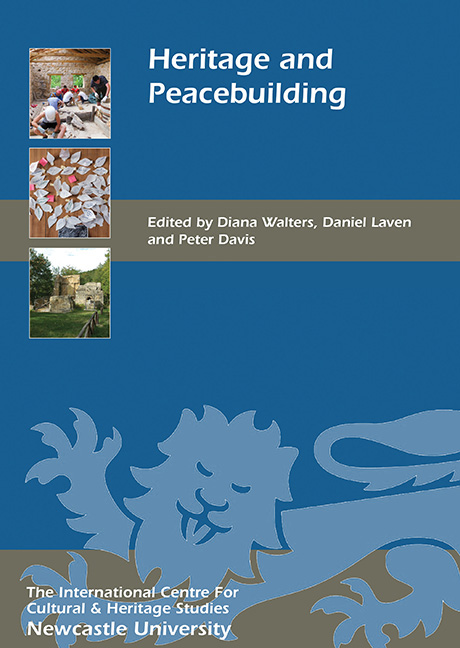Book contents
- Frontmatter
- Contents
- List of illustrations
- Acknowledgements
- List of abbreviations
- Preface
- Introduction
- NEW AND EMERGING IDEAS AROUND HERITAGE AND PEACE
- 1 The Heritage of Peace: the Importance of Peace Museums for the Development of a Culture of Peace
- 2 A Conversation with Seth Frankel: Designing Exhibitions for Peace
- 3 Public Spaces for Strangers: the Foundation for Peacebuilding and Implications for Heritage Institutions
- 4 Can Museums Build Peace? The Role of Museums in Peacebuilding and Internationalism
- 5 Information and Communication Technologies for Heritage and Peacebuilding
- 6 A Conversation with David Fleming: the Role of National Museums Liverpool in Social Justice and Peacebuilding
- HERITAGE AND PEACEBUILDING IN PRACTICE
- HERITAGE, PEACEBUILDING AND SITES
- List of Contributors
- Index
- Previous Titles
3 - Public Spaces for Strangers: the Foundation for Peacebuilding and Implications for Heritage Institutions
from NEW AND EMERGING IDEAS AROUND HERITAGE AND PEACE
Published online by Cambridge University Press: 16 February 2018
- Frontmatter
- Contents
- List of illustrations
- Acknowledgements
- List of abbreviations
- Preface
- Introduction
- NEW AND EMERGING IDEAS AROUND HERITAGE AND PEACE
- 1 The Heritage of Peace: the Importance of Peace Museums for the Development of a Culture of Peace
- 2 A Conversation with Seth Frankel: Designing Exhibitions for Peace
- 3 Public Spaces for Strangers: the Foundation for Peacebuilding and Implications for Heritage Institutions
- 4 Can Museums Build Peace? The Role of Museums in Peacebuilding and Internationalism
- 5 Information and Communication Technologies for Heritage and Peacebuilding
- 6 A Conversation with David Fleming: the Role of National Museums Liverpool in Social Justice and Peacebuilding
- HERITAGE AND PEACEBUILDING IN PRACTICE
- HERITAGE, PEACEBUILDING AND SITES
- List of Contributors
- Index
- Previous Titles
Summary
The former Moscow Minister of Culture, Sergei Kapkov, said: ‘I believe that public spaces will become an emblem of these times, just as multi-storey buildings are synonymous with the Khrushchev era. If you have the right infrastructure then the social network will develop by itself. Installing skate parks and places where people can work out doesn't cost much but it has a huge effect on social capital.’
(Lee 2014)I contend that civility is built upon or helped by having public spaces that encourage strangers safely to view or pass by each other (and not necessarily interact) while they proceed on their own individualised quests.
My interest in safe cultural spaces for strangers began when I led a consultation for a museum in Israel after the beginning of the Second Intifada in 2001. The participants were community organisers representing Ashkenazi Jews, Sephardic Jews, recent Russian and Ethiopian Jewish immigrants; and Arabs, both Israeli citizens and Palestinians. I asked if there were any cultural spaces still used by all groups. I was told the only remaining such space was the Zoo. When I asked why I was told the following:
• The content – animals – was of interest and not prohibited for any of the groups.
• The space was conducive to family outings, which are important to each of the specific cultures.
• Each visiting group could keep their own family/social unit around them, while at the same time viewing other families at a safe distance.
• They could bring their own trusted food and picnic while others did the same, even though the cuisine was different.
Their responses have become a touchstone for my subsequent work. I understood the following lessons: if groups watch others and can build a narrative of commonality, people begin to trust each other. Each of the individuals or groups came on separate missions, fulfilled them, and left safely with no obligation for further involvement. Successfully transited, the visited site becomes also true; when a marketplace is bombed by a terrorist the damage lingers beyond the immediate physical damage and creates the aura of a publicly unsafe space for a period of time. a recommended location to one's neighbours – an endorsement that slowly spreads. The reverse is
- Type
- Chapter
- Information
- Heritage and Peacebuilding , pp. 25 - 38Publisher: Boydell & BrewerPrint publication year: 2017



